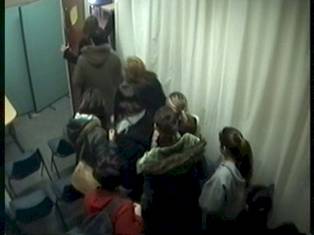

Room evacuation experimental studies
One of the aims of the present project was to develop an experimental simulation that was both engaging and ethically sound. We therefore compared two types of experimental simulation to determine which was more suitable for further development: (i) a visualization (‘virtual reality’) design, and (ii) a room evacuation design.
We ran three room evacuation studies, each time trying to develop and build upon the format. One-hundred and thirty and 81 participants respectively took part in the first two studies. They gathered in a laboratory room in groups of up to 20 people at a time and were asked to imagine they were evacuating a room in an emergency, a technique known as role-play. Various cues were provided to enhance the simulation, such as a siren and verbal requests that they leave as quickly as possible.
To test the idea that a shared social identity (psychological ‘groupness’) makes mutual concern and helping more common and personally selfish behaviours less common than if people see themselves just as different individuals, we treated one half of the participants each time as members of a relevant social category (e.g., ‘Sussex University students’) but addressed the rest simply as individuals. We then observed and filmed their behaviours (looking at the extent of helping, waiting for others to go first versus stepping in front of others, for example). We also gave participants a questionnaire at the end to measure subjective factors, such as level of identification with the group and feelings towards the other people evacuating.
Both studies failed to find significant differences across the conditions, either in behaviour or subjective reports. Looking at the process behind these results can help explain why. First, participants often did not take the scenario seriously enough. There was no sense of urgency and haste and hence no need to let others go first or push them out of the way. Second, the main behavioural measure – whether they pushed or formed a bottleneck at the door – was inadequate, i.e. the evacuation was over too quickly to give people an opportunity to display selfish versus helping behaviours.


We addressed the problems of these first two studies with a new design which embedded the ‘evacuation’ within an unrelated, fake ‘intelligence test’. Thus we didn’t rely upon role play or imagination, but still asked people to enter or leave a room as quickly as possible in order to complete the tests. As this design meant that the group of participants had to each go through the door in a hurry twice, there were also more opportunities for displaying the behaviour of interest.
Again however analysis of this study revealed no differences on our main measures. It was understood from the outset that the lack of real threat would create issues in trying to render an emergency evacuation into an experimental simulation. Moreover we mostly failed in these studies to get those in the ‘shared identity’ condition to see themselves as a group. These features point to the limits of this kind of design for studying emergency evacuation behaviour.
However, our informal observations and some of the participant feedback we gathered from this last room evacuation study suggested that, while our experimental manipulations didn’t work as intended, they had effects in line with some of the suggestions of the social identity approach. Thus, according to self-categorization theory, one factor that may lead us to see ourselves as group members (rather than as individuals) is a common relationship or a shared fate in relation to some external other. In the third study, whether we attempted to impose a social or a personal identity on our participants, simply by cramming them into a small room together, we (unintentionally) made them see themselves as a group in relation to ourselves, the experimenters. Thus, while the study was set up to look at the different effects of given social identities (i.e. personal identity versus social identity), it seemed in effect to say something about the process whereby a personal identity becomes transformed into a social identity. The significance of this question of the transformation of identities in relation to a common relationship to an external agent or force only became clear in the comparative interview study.
The visualization paradigm was judged to provide a more adequate methodology for studying evacuation behaviour: There was more psychological engagement with the visualization than the room evacuation method: participants took the visualization more seriously overall. The visualization also included more measures (more opportunities for helping versus personally selfish behaviours) than the room evacuation.